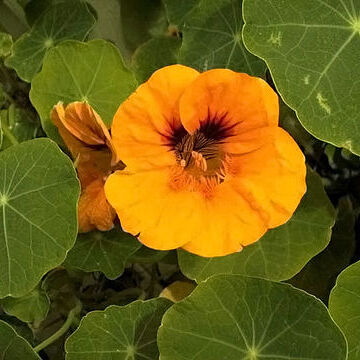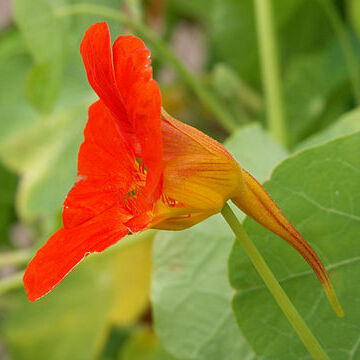Herbs, annual [perennial]; usually glabrous; roots fibrous [tuberous], (producing glucosinolates). Stems often trailing [climbing]; not branched. Leaves alternate, simple; usually stipules present; petiole present (often twining); blade (peltate), margins entire or sinuate. Inflorescences axillary, flowers solitary; bracts absent. Pedicels present. Flowers zygomorphic; sepals 5, imbricate, adaxial 1 (or 3) prolonged into slender nectariferous spur; petals 5 (sometimes fewer by abortion), imbricate, clawed, distal 2 smaller than the others; stamens 8, (barely exserted) in 2 whorls, unequal; anthers 2-celled, dehiscence longitudinal; pistil 1; ovary 3-carpellate, 3-locular; placentation axile; ovule (1 per locule, pendulous from apex), anatropous, bitegmic; style 1 (apical); stigmas 3, linear. Fruits schizocarps (mericarps), 1-seeded, fleshy or dry. Seeds 1, (greenish), ovoid; embryo straight; endosperm absent.
Herbs, annual or perennial, semi-succulent, the perennials often with tuberous roots, often climbing by coiling petioles; producing mustard oil. Leaves alternate, peltate or palmate, entire or lobed; stipules present (sometimes in seedlings only) or absent. Flowers solitary in axils, bisexual, showy, zygomorphic Sepals 5, free or shortly fused, the upper (adaxial) one (or sometimes 3) forming a backward-projecting nectariferous spur. Petals 5, free, clawed, the 2 upper differing from the 3 lower, the latter sometimes reduced or absent. Stamens 8, in 2 series of 4, all free; anthers basifixed, opening by lateral longitudinal slits. Ovary superior, 3-locular, ovules 1 per locule. Style terminal, trifid near apex. Fruit separating into 3, 1-seeded drupe-like or nut-like mericarps, or rarely a samara.


